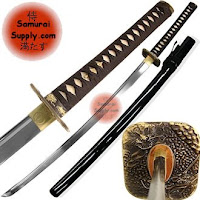
In our Musashi Katana collection, we have a sword called the Musashi Toradragon Katana Sword (SS761-1). This Katana Sword is a hand forged 1095 high carbon steel blade and is tempered using the Yaki-ire method. There have been a few questions on what the Yaki-ire method is, so we thought we would give you a bit more information on it.
Yaki-ire Tempering:
1)After the forging and the final shaping the blade is covered with clay, a thick layer on the body and a thinner layer on the edge where the Yakiba will be. After the clay has dried, the sword is placed in a charcoal fire until the temperature reaches approximately 700 degrees centigrade (1290 degrees Fahrenheit) on the back and 800 degrees centigrade (1470 degrees Fahrenheit) on the edge. Due to the heating, the blade gains somewhat in dimensions, and the tip curves a little upwards. At this point, it is then plunged into a container with water of a temperature of about 20 degrees centigrade (70 degrees Fahrenheit).
2) In the water, the edge, which has a thinner clay coating, cools off faster than the main body of the sword - the thicker clay, together with the greater thickness of the blade itself, keeps the heat longer than in the edge portion. The material at the edge contracts, and two seconds after the swords has been put into the water the blade curves slightly towards the edge; this is called Saka-zori or Gyaku-zori ("reversed Sori").
3) Five seconds after the blade was immersed in water, the rapid cooling of the edge caused a transformation of the steel structure from austenite (a nonmagnetic solid solution) to martensite (a very hard and brittle solid solution of iron and carbon), resulting in an expansion of the edge. The body of the sword, cooling off slower and losing its expansion which was caused by the heat, crystallizes into pearlite (a mixture of iron and cementite [iron carbide]). In other words: the edge expands while the back shrinks, thus gaining a Sori towards the back, the typical shape of a Nihonto.
We hope this helps out all your questions about Yaki-ire tempering and that we gave you a bit of insight of what goes on behind making this awesome Musashi Toradragon Katana Sword! We have a great sale going on now, so be sure to add this Katana Sword to your collection today! If you have any questions or comments, please feel free to contact us at info@samuraisupply.com.
No comments:
Post a Comment